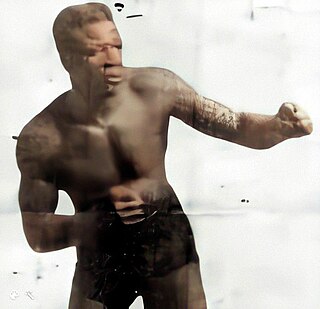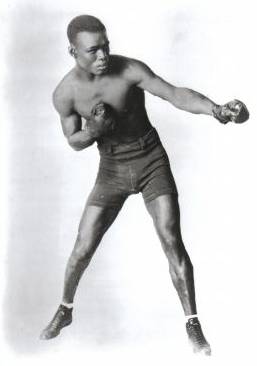Related Research Articles

Edward Henry Greb was an American professional boxer. Nicknamed "The Pittsburgh Windmill", "The Smoke City Wildcat" and "The Pittsburgh Bearcat," he is widely regarded by many boxing historians as one of the best pound for pound boxers of all time.

Edward Patrick "Mickey" Walker was an American professional boxer who held both the world welterweight and world middleweight championships at different points in his career. Born in Elizabeth, New Jersey, he was also an avid golfer and would later be recognized as a renowned artist. Walker is widely considered one of the greatest fighters ever, with ESPN ranking him 17th on their list of the 50 Greatest Boxers of All-Time and boxing historian Bert Sugar placing him 11th in his Top 100 Fighters catalogue. Statistical website BoxRec rates Walker as the 6th best boxer to have ended his career at middleweight, while The Ring Magazine founder Nat Fleischer placed him at No. 4 among greatest middleweights of all time. The International Boxing Research Organization ranked Walker as the No. 4 middleweight and the No. 16 pound-for-pound fighter of all-time. Walker was inducted into the Ring magazine Hall of Fame in 1957 and the International Boxing Hall of Fame as a first-class member in 1990.

Samuel Edgar Langford was a Canadian boxing standout of the early part of the 20th century. Called the "Greatest Fighter Nobody Knows", by ESPN, Langford is considered by many boxing historians to be one of the greatest fighters of all time. Originally from Weymouth Falls, a small community in Nova Scotia, he was known as "the Boston Bonecrusher", "the Boston Terror", and his most famous nickname, "the Boston Tar Baby". Langford stood 5 ft 6+1⁄2 in (1.69 m) and weighed 185 lb (84 kg) in his prime. He fought from lightweight to heavyweight and defeated many world champions and legends of the time in each weight class. Considered a devastating puncher even at heavyweight, Langford was rated No. 2 by The Ring on their list of "100 greatest punchers of all time". One boxing historian described Langford as "experienced as a heavyweight James Toney with the punching power of Mike Tyson".
The World Colored Heavyweight Championship was a title awarded to black boxers in the late nineteenth and early twentieth centuries. This was the only recognized heavyweight championship available to black boxers prior to Jack Johnson winning the world heavyweight title in 1908. The title continued to exist until the reign of Joe Louis as universally recognized champ, as the color bar against black heavyweights was enforced during and for a generation after Jack Johnson's reign as world champ.

Kid Norfolk was an American professional boxer who fought as a Light Heavyweight and Heavyweight from 1910 through 1926, holding wins over many notable boxers of his day including Joe Jeanette, Billy Miske, Jack Blackburn, Harry Greb, Tiger Flowers, Battling Siki, and Gunboat Smith. Norfolk was inducted into the International Boxing Hall of Fame in 2007.

"Battling" Jim Johnson was an American boxer who fought as a heavyweight from 1908 to 1918. He had little success and lost with great frequency to top boxers such as Sam Langford, Joe Jeanette, Sam McVey, Harry Wills and Kid Norfolk.
Herbert Lewis Hardwick Arroyo, also known as "Cocoa Kid", was a Puerto Rican boxer of African descent who fought primarily as a welterweight but also in the middleweight division. Hardwick won the World Colored Championships in both divisions. He was a member of boxing's "Black Murderers' Row" and fought the best boxers of his time. He was inducted into the International Boxing Hall of Fame in 2012.
Obie Walker, born Obie Dia Walker in Cochran, Georgia, was a professional boxer. Walker was the penultimate World Colored Heavyweight Champion from October 9, 1933, when he out-decisioned title holder George Godfrey in a 10-round fight at the Arena in Philadelphia, Pennsylvania, to July 20, 1935, when he lost the title on a decision in a 15-round bout to former colored heavyweight champ Larry Gains in Tigers Rugby Stadium, Leicester, England.

Big Bill Tate was an American boxer who fought from 1912 to 1927. A native of Montgomery, Alabama, he spent his fighting career based in Chicago. Tate was a regular sparring partner of heavyweight champion Jack Dempsey, yet Dempsey denied him a shot at the title.

Klondike Haynes was an African American boxer billed as "The Black Hercules" who declared himself the black heavyweight champion. Born John Haines or John W. Haynes, the 6-foot (1.8 m) tall Klondike fought out of Chicago as a heavyweight at a weight of 190–200 pounds (86–91 kg) from 1898 to 1911. He took the nickname because he was supposed to be a great find.
The World Colored Middleweight Championship was a title awarded to black boxers in the late nineteenth and early twentieth centuries. This was the only recognized middleweight championship available to blacks prior to Tiger Flowers winning the world middleweight boxing championship by defeating Harry Greb on 26 November 1926.
Larry Estridge was a middleweight boxer and the last holder of the World Colored Middleweight Championship. The 5'7" middleweight fought out of New York City from 1922 to 1929, racking up a career record of 53 wins against 23 losses and two draws from 1922 to 1929.

Panama Joe Gans was a black boxer who held the World Colored Middleweight Championship for four years, shortly before it was discontinued. Born Cyril Quinton Jr. on November 14, 1896, in Barbados, British West Indies and raised in the Panama Canal Zone, the 5'7" Quinton originally fought out of Panama and then New York City. He took his ringname from boxing great Joe Gans, the first black American fighter to win a world boxing title. He found his greatest fame fighting as a middleweight at between 147 and 160 lbs, but in his early career he took the Panamanian Lightweight Title and contended for the Panamanian Welterweight Title at weights roughly between 130 and 147 pounds.
The World Colored Welterweight Championship was a title that existed during the time of the color bar in professional boxing.

Young Peter Jackson was an African American boxer active from 1929 to 1939. Born Peter Martin in Los Angeles, California, he renamed himself in honor of the great colored heavyweight champ Peter Jackson and the welterweight contender Peter Jackson. The 5'7" Jackson fought as a lightweight, making his professional debut on August 14, 1929 at the Wilmington Bowl in Wilmington, California, when he knocked out Herb Yales via a knock out in the first round of a scheduled four-round bout.
Lee Anderson was a boxer who fought between 1914 and 1929. The 5'10" Anderson fought out of Oakland, California as a light heavyweight. He was the first holder of the World Colored Light Heavyweight title.
Gorilla Jones was an African American boxer known as "The Fighting Gorilla" who fought out of Alexandria, Louisiana as a welterweight from 1913 to 1924. He may have provided the nickname for William Landon Jones (1906–1982), also known as Gorilla Jones, who was the second black boxer to win the world middleweight title.
Eddie Palmer was an African American boxer who held the World Colored Welterweight and World Colored Middleweight titles. Born in New Orleans, Louisiana in 1892, the 5'9" Palmer fought at a weight of between 142 and 156 lbs. out of Philadelphia and New Orleans between 1910 and 1925. He moved to Philadelphia in August 1911 and fought out of the City of Brotherly Love for two years.
The Jamaica Kid was a boxer born Robert Buckley in British Honduras who fought out of New Orleans and New York City as a professional from 1916 to 1928, primarily as a light-heavyweight. When he was based in Louisiana in the first year of his pro career, he won the World Colored Middleweight title from Eddie Palmer in New Orleans, a title he did not defend as he moved to New York City later that year.
The Black Heavyweight Championship was a title in pretense claimed by the African American boxer Klondike, who was born John Haines or John W. Haynes and by two-time colored heavyweight champ Frank Childs.
References
- ↑ "Kid Norfolk - Record". BoxRec.
- ↑ "Lee Anderson - Record". BoxRec. Retrieved 26 May 2012.
- ↑ "Tiger Flowers - Record". BoxRec.